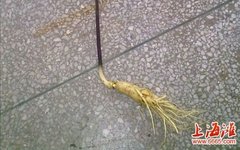
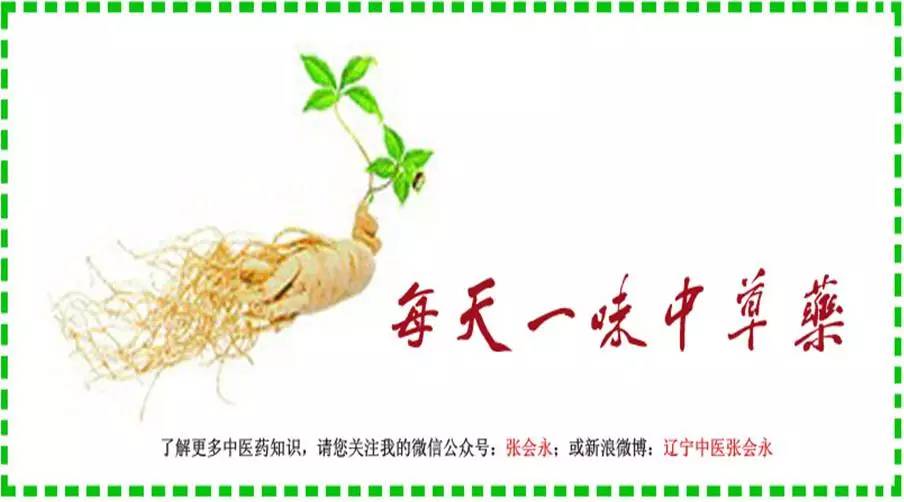
Ginseng, with many varieties, can you distinguish them? Do you know how to choose? Can you tell apart good wild ginseng from cultivated ginseng? Have you heard the story of harvesting ginseng with a red string? …
Ginseng (Ren Shen), a member of the Araliaceae family, has an upright stem that does not branch; it grows one leaf in its first year, which divides into three small leaflets. In its second year, it still has one leaf but divides into five small leaflets, and it takes three years to grow two leaves, with a maximum of eight leaves, which is extremely rare. Typically, it flowers in three years, producing pale yellow-green umbellate flowers; in five years, it bears flat, round, bright red fruits. Wild ginseng is known as mountain ginseng (Shan Shen), while cultivated ginseng is called garden ginseng (Yuan Shen). After drying, it is referred to as raw ginseng (Sheng Shai Shen); after blanching in water and soaking in sugar, it is called white sugar ginseng (Bai Tang Shen); and after steaming and drying, it is called red ginseng (Hong Shen). Its efficacy is to greatly tonify the vital energy (Yuan Qi).
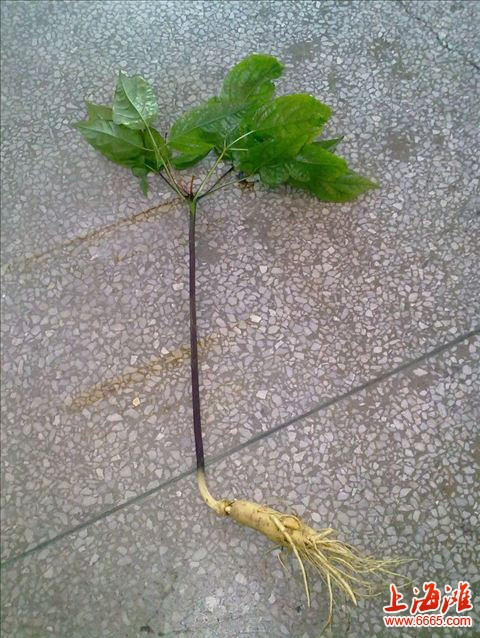
Ginseng is a perennial plant of the Araliaceae family, with its medicinal part being the root. The stem of ginseng is upright and unbranched.

In its first year, ginseng only grows one leaf, which divides into three small leaflets, known as “three flowers” (San Hua); in its second year, it still has one leaf but divides into five small leaflets, called “palm” (Ba Zhang); it takes three years to grow two leaves, known as “two corners” (Er Jiao); in the fourth year, it increases to three leaves, called “lantern” (Deng Tai Zi); in the fifth year, it increases to four leaves, called “four leaves” (Si Pi Ye); in the sixth year, it increases to five leaves, called “five leaves” (Wu Pi Ye). There are also “six leaves” (Liu Pi Ye), and in rare cases, “seven leaves” (Qi Pi Ye) and “eight leaves” (Ba Pi Ye). When it reaches “eight leaves,” it divides into two layers, each with four leaves.
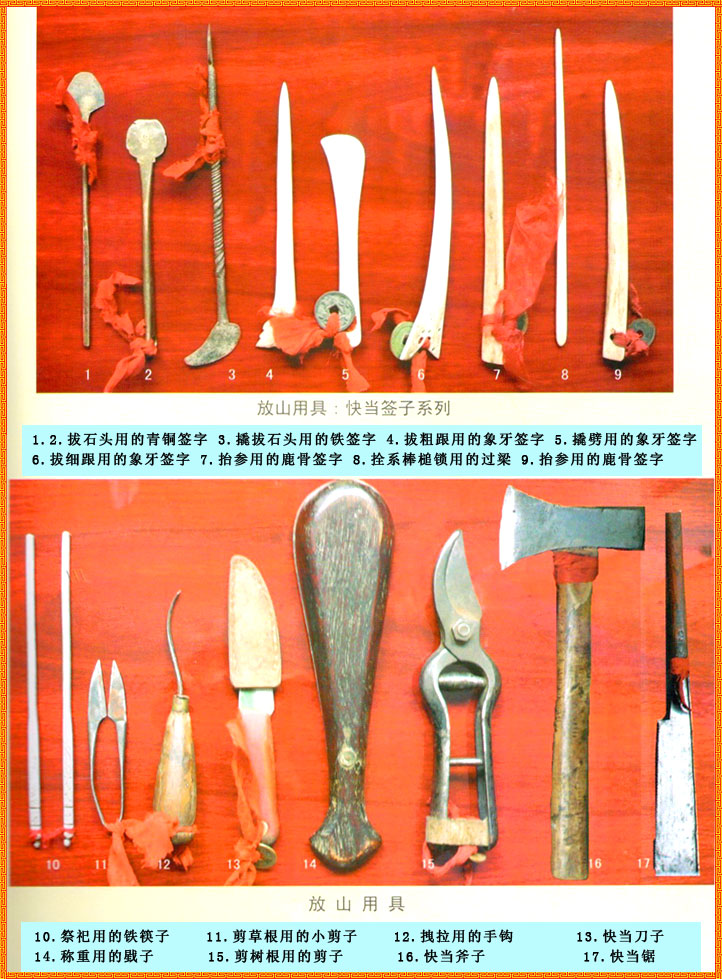
Ginseng is primarily produced in Northeast China, commonly referred to as “baton” (Bang Chui). In the past, it was mostly wild, but now it is mostly cultivated. Searching for wild mountain ginseng in deep mountains and forests in Northeast China is called “fang shan.” The leader of the fang shan team is known as “shan ba tou.” Fang shan requires unique tools, and there are many customs associated with entering and exiting the mountains. One cannot speak casually during fang shan; communication is done by tapping the sticks used for fang shan. Finding ginseng is referred to as “opening the eyes,” at which point the discoverer must shout “baton,” and the leader will ask, “What kind of goods?” The discoverer will respond with the number of leaves, and everyone will gather and shout “take it.” Then, the familiar practice of binding ginseng with red string begins. The act of digging ginseng is respectfully referred to as “lifting the baton.” Fang shan has formed a unique set of folk customs and a distinct ginseng culture among the people of Northeast China, but wild mountain ginseng is rare and has mostly been replaced by cultivated varieties, putting this fang shan custom at risk of being lost. (Today’s article is too long; the customs of fang shan will be attached under tomorrow’s article on American ginseng, so please pay attention.)
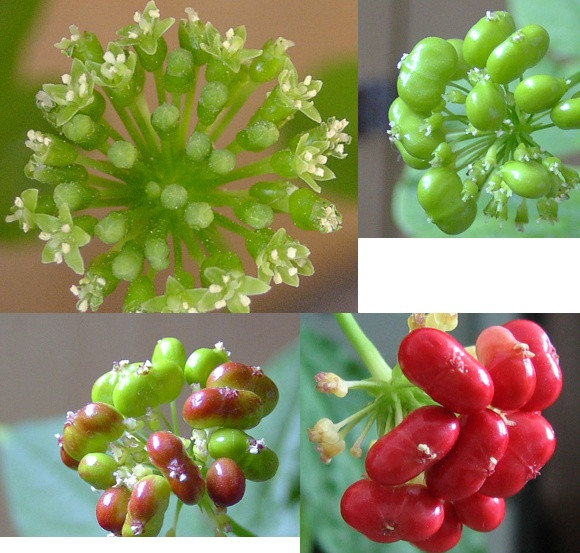
Ginseng typically flowers in three years, producing pale yellow-green umbellate flowers; in five years, it bears flat, round, bright red fruits containing two semi-circular seeds. This attracts the “baton bird” (Ren Shen Niao) to peck at the fruit, which digests only the flesh and excretes the seeds in the mountains, allowing wild ginseng seedlings to grow. Experienced fang shan gatherers say that ginseng fruit that has not been eaten by the “baton bird” will not germinate. When searching for ginseng, an experienced leader can locate it by the call of the ginseng bird; there is a saying that where the ginseng bird calls, there is ginseng. However, which bird is the ginseng bird remains a matter of debate.
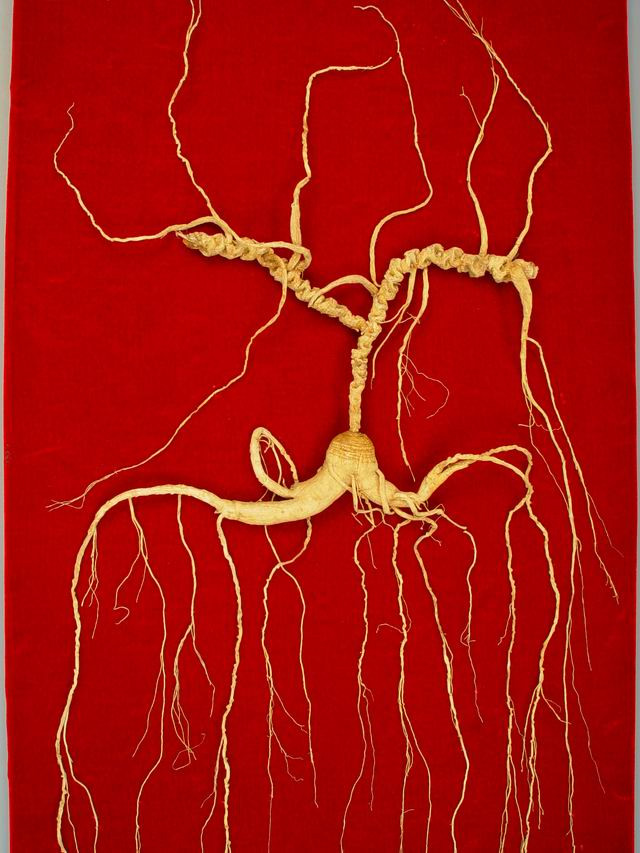
Ginseng has a particularly strong regenerative ability; wild mountain ginseng can survive temperatures as low as -40°C; it is resistant to drought and the trampling of wild animals. Even if the buds are damaged, it will sprout new shoots and continue to grow. The ginseng’s rhizome has “rhizome cups,” each with backup buds. If any rhizome cup is accidentally damaged, its backup bud can continue to grow, becoming a new rhizome cup. Even if the rhizome is broken, new buds can sprout after a few years. Even if the main root is severed, ginseng can still sprout new buds. If the main root rots, the remaining fibrous roots can still grow, and after decades or even a hundred years, the fibrous roots can become the main root.
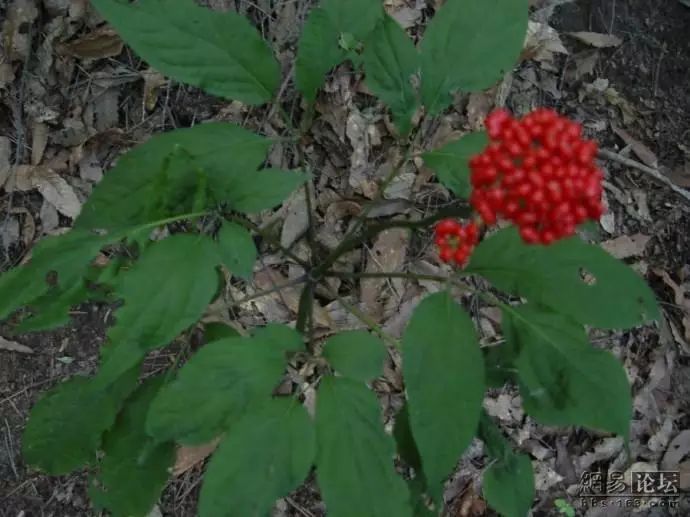
Ginseng generally grows to six leaves; if the ginseng bud is damaged, the regenerating bud will start growing from the “three flowers,” “five-leaf palm,” or “two corners,” continuing the cycle. Therefore, sometimes small ginseng that appears to be “two corners” can actually be large ginseng when dug up. Fang shan gatherers say that ginseng can change its form. (The image above shows a rare seven-leaf ginseng, which can be called the king of ginseng.)
Types of Ginseng
There are many varieties of ginseng. They can be roughly divided into the following categories:
Based on Growing Environment
Wild ginseng is called “mountain ginseng” (Shan Shen) or “wild mountain ginseng” (Ye Shan Shen). Due to the harsh growing conditions in the wild, ginseng grows extremely slowly and exhibits typical characteristics of rhizomes, fibrous roots, body, and markings.
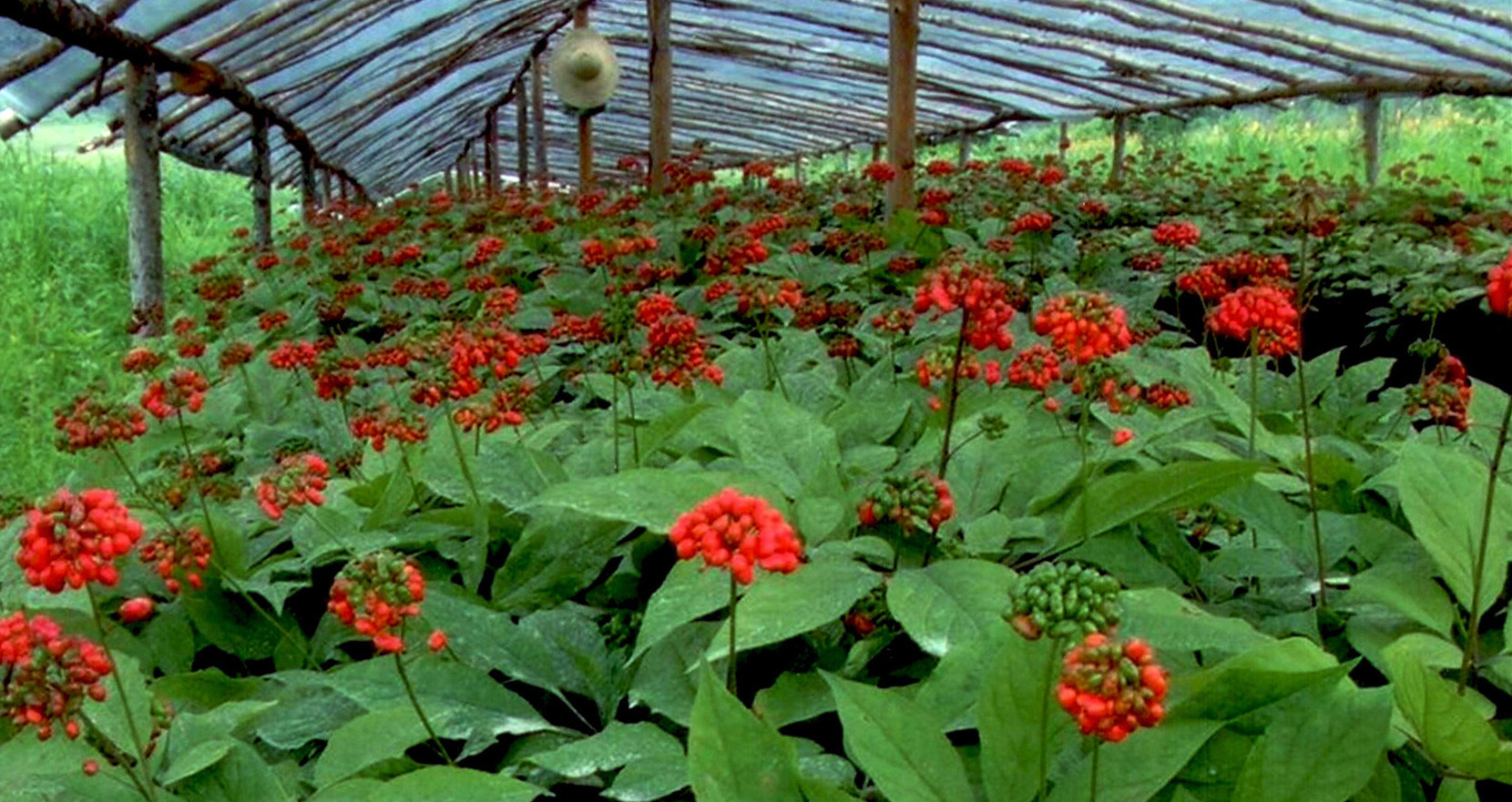
Cultivated ginseng grown in fields is called “garden ginseng” (Yuan Shen). It is watered and fertilized, growing in a comfortable environment, thus it is plump and grows quickly, resembling a radish.
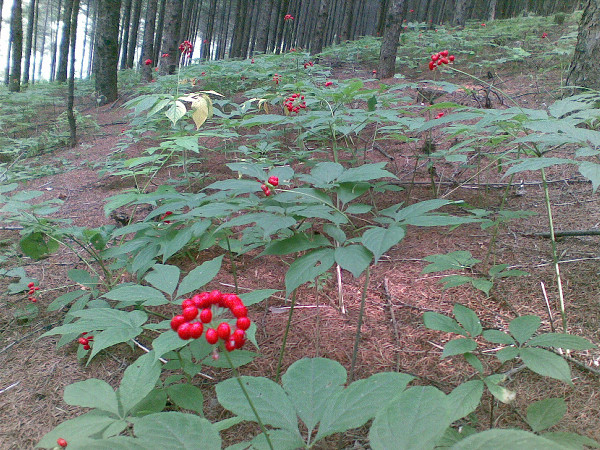
Cultivated ginseng grown in forests, growing naturally, is called “forest ginseng” (Lin Xia Shen). There is also a type called “transplanted mountain ginseng” (Yi Shan Shen), which is divided into “mountain transplant” (Shan Yi) and “home transplant” (Jia Yi). “Mountain transplant” refers to discovering wild mountain ginseng seedlings during fang shan and transplanting them to nearby mountains and forests for easier management; “home transplant” refers to ginseng farmers transplanting garden ginseng seedlings to mountain forests without watering or fertilizing, allowing them to grow naturally in the wild.
Based on Origin
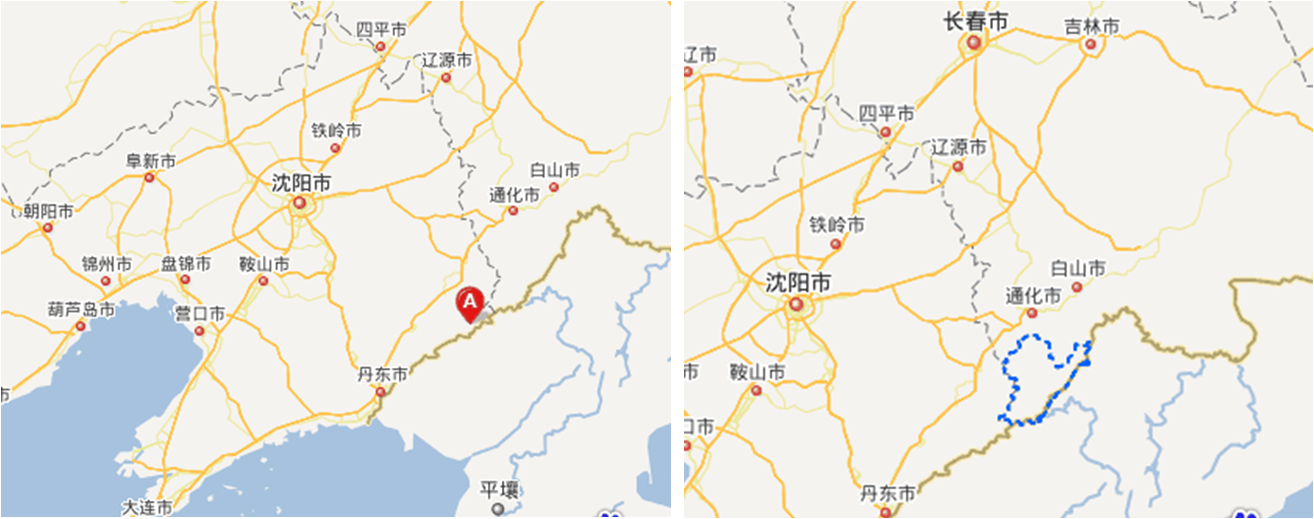
Famous garden ginseng varieties in China include Shizhuzi ginseng (Zhu Shen) and Bian Tiao ginseng (Bian Tiao Shen). “Shizhuzi ginseng” is abbreviated as Zhu Shen, produced in Shizhuzi Village, Zhenjiang Town, Kuandian Manchu Autonomous County, Liaoning Province. It is the best among garden ginseng, cultivated from wild mountain ginseng under simulated wild conditions without fertilization or medication, growing extremely slowly, harvested after 15-20 years, with an average weight of about 30 grams per root.
“Bian Tiao ginseng” is produced in Jilin Province, Jianshi City, and is harvested after two transplants in 6-8 years, with each root not being very heavy. The rest are ordinary garden ginseng, harvested in less than 6 years, with larger ones weighing several taels. Ginseng grown in North Korea and South Korea is collectively referred to as “Korean ginseng” (Gao Li Shen), which is not much different from domestic varieties.
Based on Processing Methods
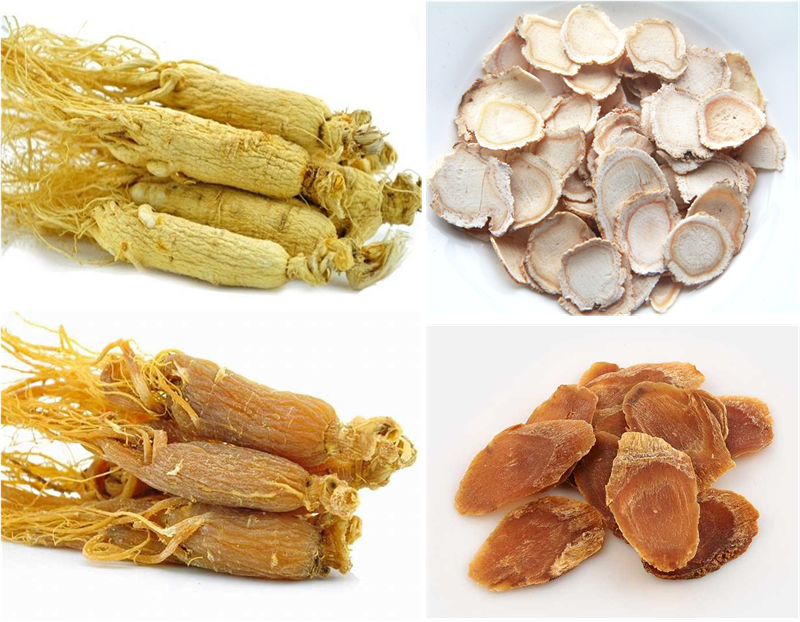
Fresh garden ginseng is called “water ginseng” (Shui Shen), while ginseng that is directly dried is called “raw dried ginseng” (Sheng Shai Shen), which is white in color and also known as “white ginseng” (Bai Shen); if ginseng is steamed and then dried, it turns red and semi-transparent, known as “red ginseng” (Hong Shen). Red ginseng is essentially cooked ginseng, with milder effects. “Powerful ginseng” (Da Li Shen) is ginseng that is soaked in boiling water for a short time and then dried, falling between raw dried ginseng and red ginseng.
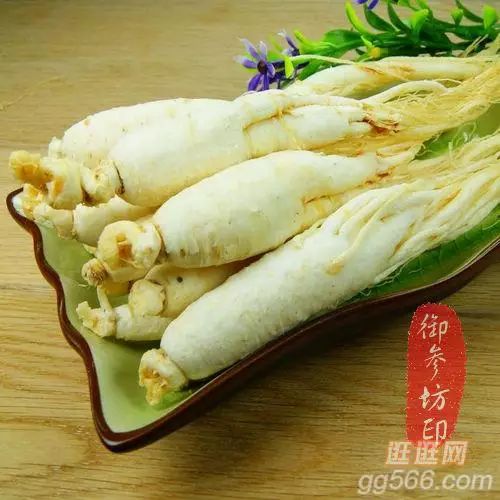
There are also some inferior quality ginseng that is not suitable for processing into red ginseng. After soaking in water, they are pricked with needles and then soaked in concentrated sugar water and dried, known as “white sugar ginseng” (Bai Tang Shen) or “sugar ginseng” (Tang Shen). Although it tastes good, the effective components are greatly lost, making it similar to a sugar stick. There is also “peeled ginseng” (Qia Pi Shen), which is processed similarly to sugar ginseng, soaked in a less concentrated sugar solution to separate the skin from the inner part, and then pricked with a bamboo knife to create many small dents on the surface.
Additionally, there is American ginseng (Xi Yang Shen), which is different from ginseng and is a separate discussion.
Identification of Wild Mountain Ginseng
Wild mountain ginseng generally grows for over ten years or even a hundred years, which is no exaggeration. However, wild mountain ginseng is now extremely rare, and there are many fakes. When I was in school, I saw a genuine specimen of mountain ginseng in the school specimen room, one of which was dug up by a teacher during a medicinal herb collection trip with students. To identify wild mountain ginseng, one must examine five aspects: rhizome, fibrous roots, body, whiskers, and markings.

Rhizome: This is the part connecting the root and stem, also known as the rhizome head. Older wild mountain ginseng has a longer rhizome, which can be divided into two-section rhizomes, three-section rhizomes, line rhizomes, and goose neck rhizomes. Two-section rhizomes can be further divided into horse tooth rhizomes and round rhizomes. Three-section rhizomes can be horse tooth, round, and pile flower rhizomes. The so-called horse tooth rhizome has obvious stem scars resembling horse teeth, mostly found on the upper part of the rhizome. Round rhizomes are those whose stem scars have flattened over time, resembling cylindrical shapes. Line rhizomes are those with flattened rhizome cups and thin, long rhizomes due to age. Goose neck rhizomes are thin and slightly curved, resembling a goose neck. The stem scars on the rhizome are also known as rhizome cups, with each rhizome cup representing one year. However, in older mountain ginseng, some rhizome cups may have faded; the longer the rhizome grows, the more rhizome cups it has, indicating the age of the mountain ginseng. (Please refer to the following images for better understanding.)
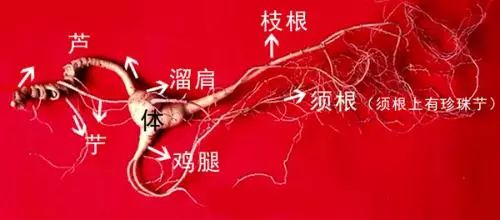
Fibrous roots: These are the adventitious roots growing on the rhizome, which can be divided into jujube kernel fibrous roots, hairy fibrous roots, and transformed fibrous roots. Adventitious roots are thicker and resemble jujube kernels, known as jujube kernel yam; smaller ones are called hairy fibrous roots, and fibrous roots can swell and transform into root fibrous roots.
Body: This refers to the main root, which has a yellow-brown or gray-yellow skin, with a cross-section appearing yellow-white. Based on shape, it can be classified into spiritual body, nodular body, straight body, over-beam body, clumsy body, and horizontal body. If the skin is tender and white, it is not pure mountain ginseng.
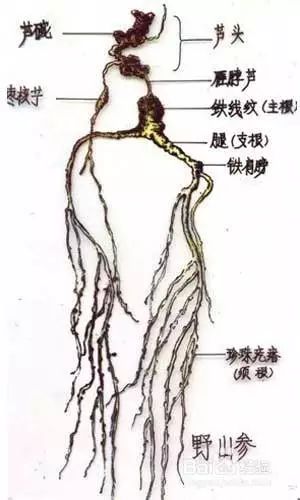
Whiskers: These are long, thin whiskers that are old and tough, clear and sparse, with strong flexibility and elasticity, adorned with small, millet-like bumps known as “pearl dots.” Fake mountain ginseng has short and brittle whiskers that easily break and lack pearl dots.
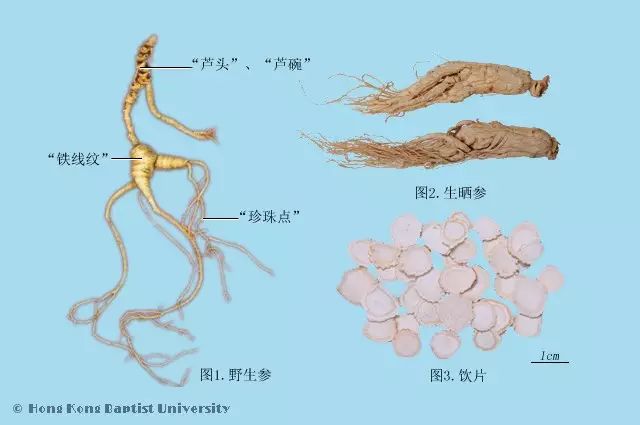
Markings: There are fine and deep ring markings on the shoulder of the main root, resembling screw patterns, known as “iron wire markings.” Fake mountain ginseng has rough, shallow, and discontinuous markings.
Medicinal Value of Ginseng
Ginseng has a sweet taste, greatly tonifies vital energy, quenches thirst, generates fluids, and regulates the nutritive and defensive Qi.
The first herb in the classical Chinese medicine text “Yao Xing Ge Kua Si Bai Wei” from the Ming Dynasty is ginseng: “Ginseng has a sweet taste, greatly tonifies vital energy, quenches thirst, generates fluids, and regulates the nutritive and defensive Qi.” When I memorized it in school, I found it did not rhyme and the effects mentioned differed from the textbook. Now, when I think of ginseng, the first thing that comes to mind is the verse from “Four Hundred Flavors,” and I increasingly feel it makes sense.
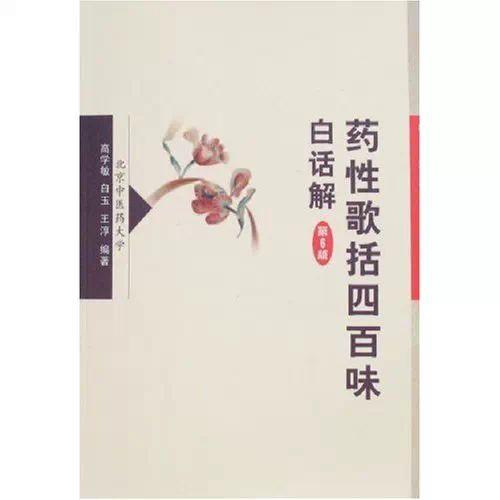
Greatly Tonifies Vital Energy
Ginseng functions to greatly tonify vital energy and is often used in critical conditions; it can also act as an anti-shock agent. Garden ginseng is weaker, while mountain ginseng is expensive, so ginseng injections such as Sheng Mai Injection and Shen Fu Injection are often used as substitutes. In clinical practice, we frequently encounter acute heart failure with shortness of breath and profuse sweating. Despite treatments to strengthen the heart, diurese, and dilate blood vessels, the heart rate remains high. Administering Shen Fu Injection intravenously can take effect shortly thereafter. (A few patients may be allergic to ginseng, so caution is advised.)
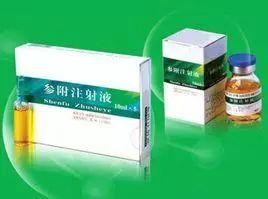
Quenches Thirst and Generates Fluids
After high fever and profuse sweating, the body becomes particularly weak, with both Qi and Yin injured, leading to unquenchable thirst and accompanying false heat. At this time, ginseng is most suitable. In the “Shang Han Lun,” Bai Hu Jia Ren Shen Tang and Zhu Ye Shi Gao Tang both use ginseng to benefit Qi and nourish Yin, thus quenching thirst and generating fluids. The famous formula Sheng Mai Yin, which consists of ginseng, Mai Dong (Ophiopogon), and Wu Wei Zi (Schisandra), can benefit Qi, nourish Yin, and restrain sweating. Elderly patients with night sweats due to deficiency can use Sheng Mai Yin. The previously mentioned Yu Ping Feng San treats exterior deficiency and spontaneous sweating, which should also be differentiated.
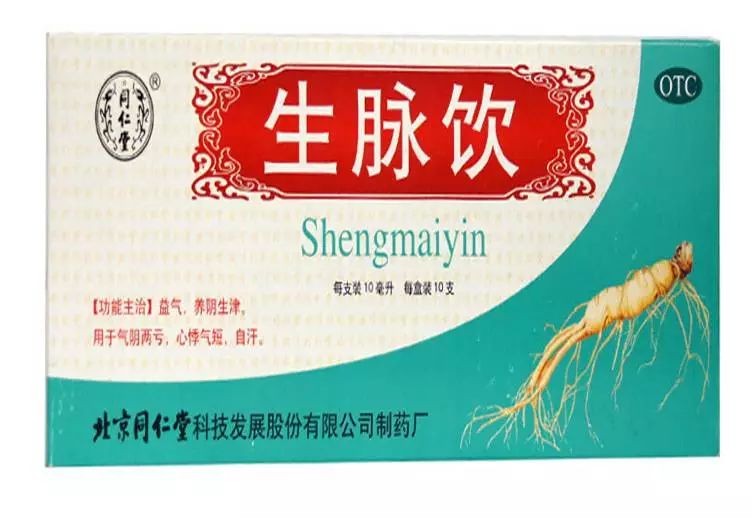
Regulates Nutritive and Defensive Qi
Regulating the nutritive and defensive Qi, as stated in the “Nan Jing,” “to damage the heart, regulate its nutritive and defensive Qi.” Ginseng benefits Qi and can calm the spirit, treating symptoms of restlessness, palpitations, and insomnia. It can also harmonize the nutritive and defensive Qi, treating spontaneous sweating and night sweats. I have personally experimented; after excessive fatigue, I sometimes find it difficult to fall asleep. After taking a few slices of ginseng or drinking ginseng tea, I immediately feel drowsy, and afterward, I sleep very soundly and wake up feeling refreshed.
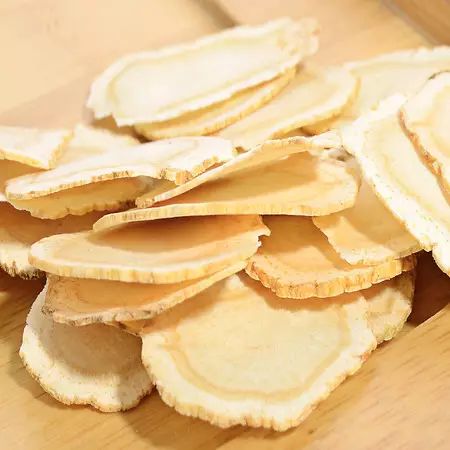
However, ginseng is not used as frequently in clinical practice; many times, Dang Shen (Codonopsis) and Tai Zi Shen (Pseudostellaria) are used as substitutes for ginseng. You can refer to the article on Dang Shen by replying with “Dang Shen” on the public account. In a few days, I will write about Tai Zi Shen.
Methods of Using Ginseng
Choosing Which Ginseng
Wild mountain ginseng is rare, and it is estimated to be very difficult to find genuine products. Even if found, it is often too precious to consume, mostly given as gifts or collected. Forest ginseng and transplanted mountain ginseng also have significant medicinal effects, but they are also quite expensive. For those who are particular, Shizhu ginseng can be chosen, while Bian Tiao ginseng is a slightly lesser option. In fact, for most people, ordinary garden ginseng is sufficient, as it is affordable and accessible.
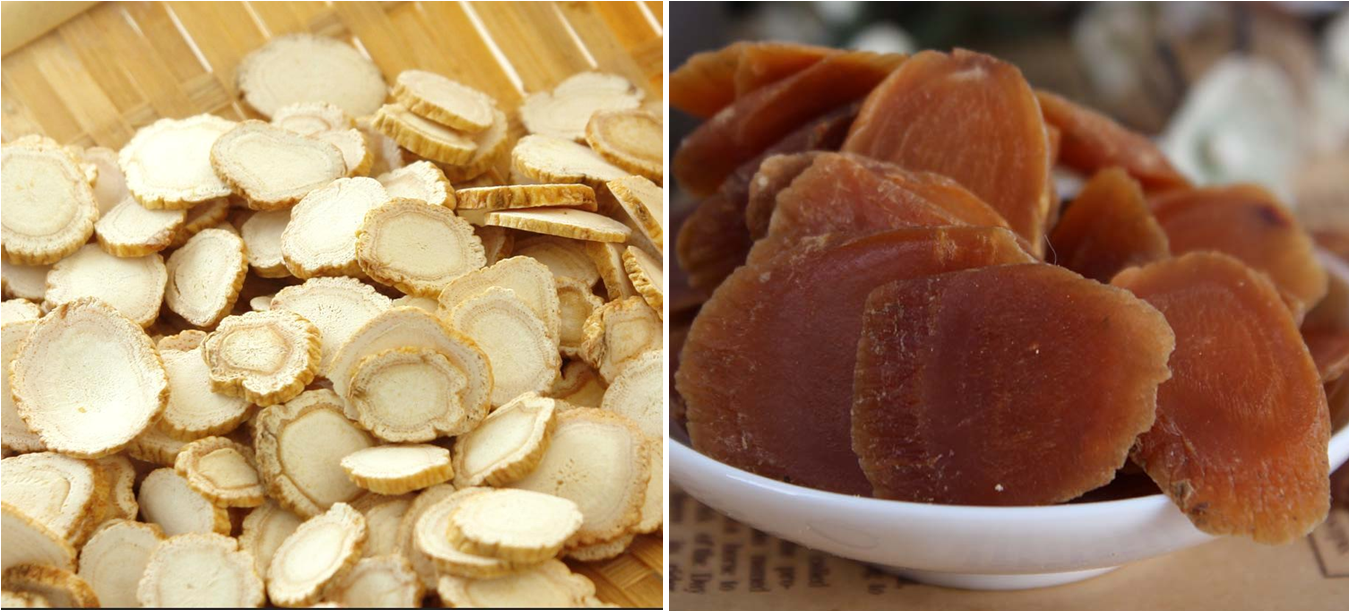
For medicinal use, raw dried ginseng (Sheng Shai Shen), also known as white ginseng (Bai Shen), should be selected, and it should not be confused with white sugar ginseng. For tonifying the body, red ginseng (Hong Shen), which has milder effects, can be chosen. Powerful ginseng and peeled ginseng are not commonly seen, while I do not recommend using white sugar ginseng, as it is of inferior quality and resembles a sugar stick, offering little benefit.
Ginseng and Nosebleeds
The garden ginseng we purchase grows quickly and has little medicinal effect, but if used in large quantities, or if young people consume it, it can lead to nosebleeds. This is not an exaggeration; I have encountered several cases around me.
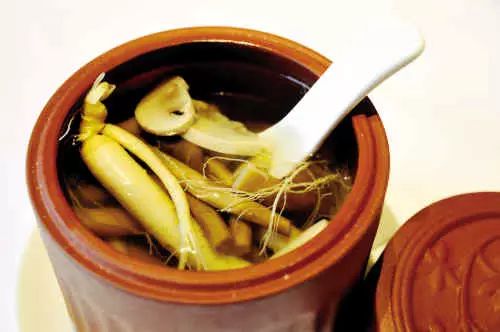
For those who are truly weak, ginseng can be used appropriately to tonify the body, but it is best to consult a doctor before use. Ginseng can be boiled in water, used in soups, cooked in porridge, or chewed; it can be used in any way.
Interesting Anecdote: Ran Xuefeng’s Clever Use of Wild Mountain Ginseng
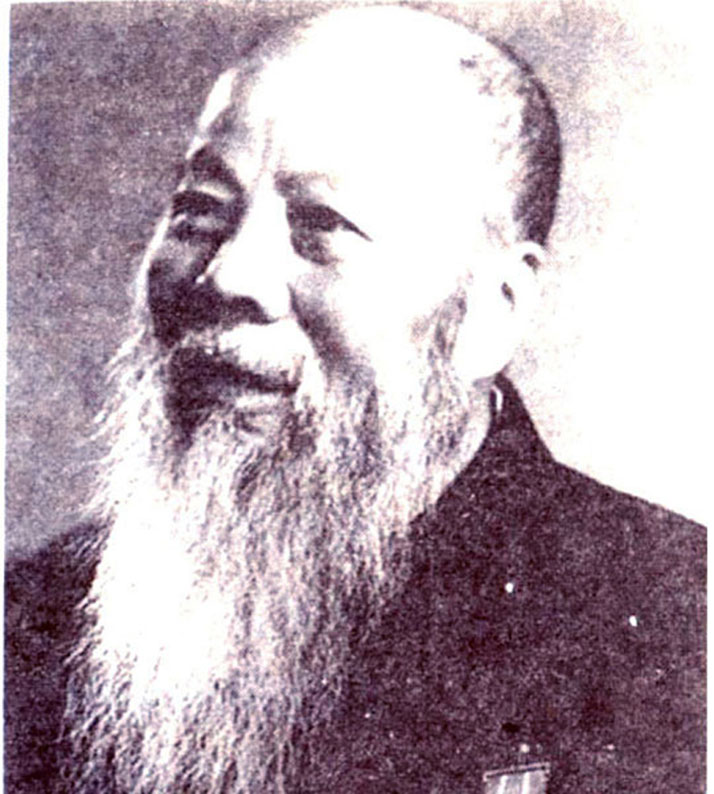
In the 1920s, the mother of the governor of Anhui Province was ill, and after repeatedly inviting medical experts from Japan and Germany without success, they invited the famous TCM doctor Ran Xuefeng for treatment. The prescription Ran provided was: Chai Hu (Bupleurum), Sheng Di (Rehmannia), Dan Pi (Moutan), Xuan Shen (Scrophularia), Hua Fen (Pollen), Zhi Mu (Anemarrhena), plus the medicinal guide of “one tael of high-quality wild mountain ginseng, calcined into white ash, and decocted as a medicinal guide.” Within a few days, she recovered. Everyone was surprised that wild mountain ginseng was used in such a way, as it had never been done before, and its efficacy was unclear. When asked, Ran Xuefeng explained: “The old lady usually lives in luxury and comfort, and she only had a cold and fever, not a serious illness. However, her son, being a high-ranking official, made a big deal out of it, inviting many Chinese and Western doctors for a minor issue. I used inexpensive medicine, but the noble did not believe in cheap medicine, so I added the precious wild mountain ginseng. Wild mountain ginseng is a powerful tonic, but it can also be harmful if misused, so I calcined it into ash for use.”
The following passage is for medical students; those who understand will understand.
“Shen Nong Ben Cao Jing”: It primarily tonifies the five organs, calms the spirit, stabilizes the soul, stops palpitations, eliminates evil Qi, brightens the eyes, and enhances intelligence.
“Ming Yi Bie Lu”: It is used to treat cold in the stomach and intestines, abdominal distension and pain, chest and flank fullness, cholera with vomiting and diarrhea, regulates the middle, stops thirst, opens blood vessels, breaks up accumulations, and aids memory.
“Yao Xing Lun”: It is used for insufficient Qi in the five organs, weakness from overwork, emaciation, vomiting, inability to eat, stops cholera, restlessness, and vomiting, tonifies the five organs and six bowels, protects the center and guards the spirit. It is also said that Ma Lin is an assistant, dispelling phlegm from the chest, treating lung atrophy, vomiting pus, and epilepsy, and alleviating cold Qi rising, preventing food intake in patients with cold and fever, and for those who are weak and have many dreams, it can be added.
“Ben Cao Gang Mu”: It treats all deficiency syndromes in men and women, fever with spontaneous sweating, dizziness and headaches, regurgitation and vomiting, obstructed malaria, prolonged diarrhea, frequent urination, fatigue, stroke, heat stroke, atrophy, vomiting blood, coughing blood, blood in urine, uterine bleeding, and postpartum diseases.
“Ben Cao Bei Yao”: It greatly tonifies vital energy and clears heat.
“Yi Xue Zhong Zhong Can Xi Lu”: As for Liao ginseng, its tonifying and warming effects are both greater than those of Dang Shen, while its nature is roughly similar to that of Dang Shen. Easterners say that excessive consumption can lead to cerebral congestion; its nature is tonifying and ascending. It is known that ginseng not only tonifies Qi but also works well with blood tonics. It is foolish to think that if combined with cooling and moistening herbs, it can tonify both Qi and blood, balancing its warming nature to prevent Yin depletion, as abundant Qi can naturally generate blood. The “Shen Nong Ben Cao Jing” states that it primarily tonifies the five organs, calms the spirit, stabilizes the soul, stops palpitations, eliminates evil Qi, brightens the eyes, enhances intelligence, all due to sufficient Qi and blood, allowing the organs and systems to receive nourishment, thus producing various effects.
Search and follow the WeChat public account Zhang Huiyong, where the author will also send you daily updates on “Daily Herb” messages.
Public account View Historical Messages: You can also read about:Tu Si Zi, Bai Mao Gen, Dang Shen, Yuan Hu, Zi Su, Lai Fu Zi, Sheng Jiang, Gou Qi Zi, Yi Yi Ren, Shan Yao, Ju Hua, Fo Shou, Xiang Yuan, Jue Ming Zi, Bai Zhu, Fang Feng, Bai Zhi, Tian Ma, Huang Qi, Bai Ji, Suan Zao Ren, Bai Zi Ren, Yuan Zhi, Shi Chang Pu, Fu Ling, Zhu Ling, Ze Xie, Ling Zhi, Dong Chong Xia Cao, He Shou Wu……

Feel free to follow my Sina Weibo and interact with me.
Click the lower left corner of the screen on“Read the original text”to enter Sina Weibo
#Daily Herb# Topic


